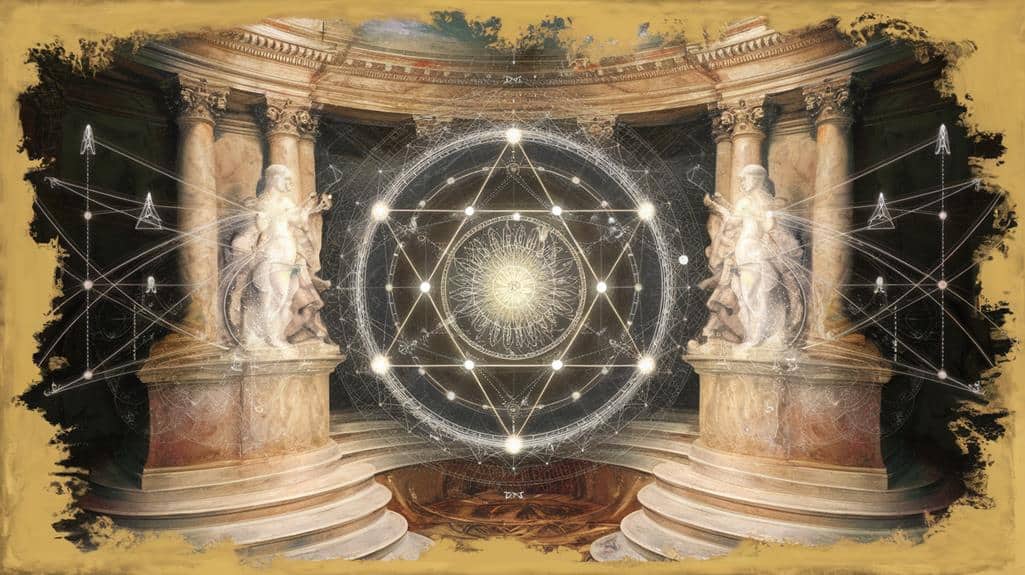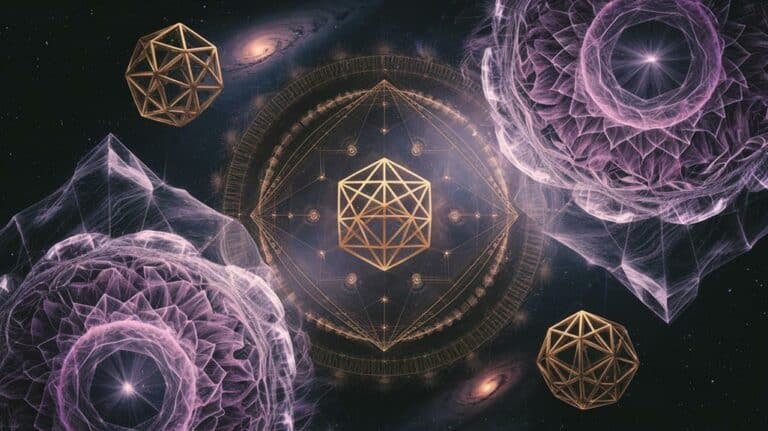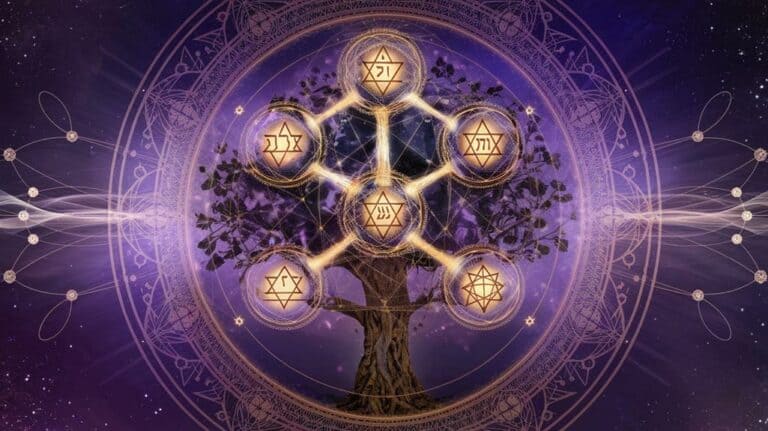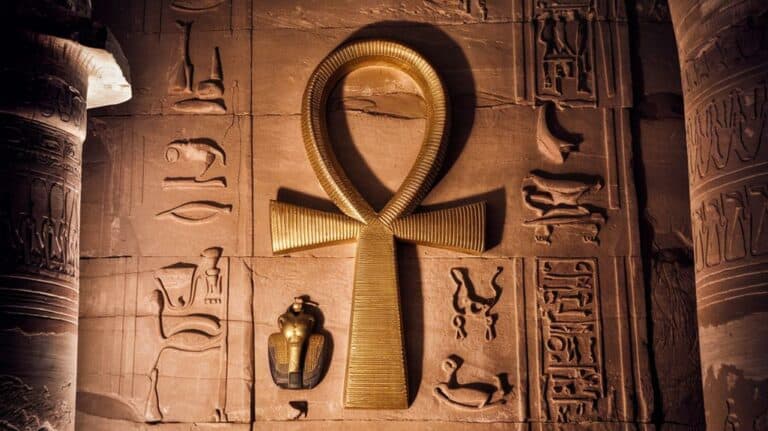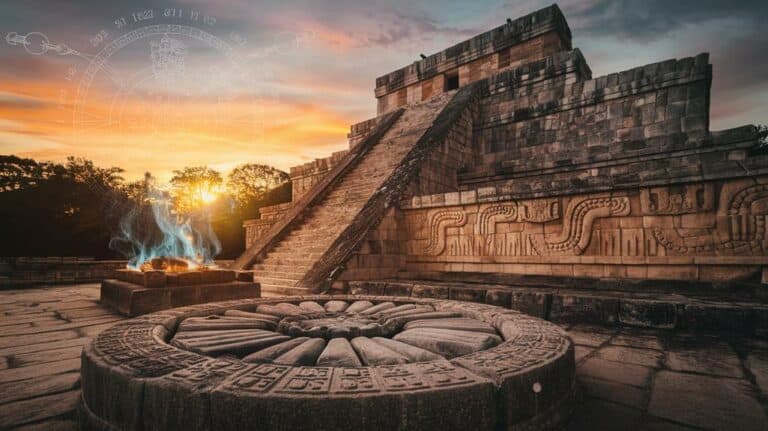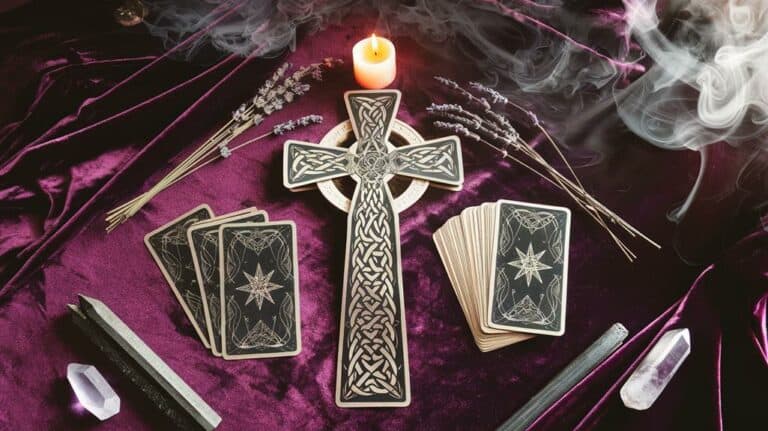10 Mystical Symbols Hidden in Famous Artworks
You’ve likely walked past countless masterpieces in museums without noticing the secret language embedded within their brushstrokes. Behind the obvious beauty of Renaissance art, Gothic architecture, and classical paintings lies a complex web of esoteric symbols that artists have used for centuries to communicate spiritual truths. From the enigmatic all-seeing eye in Michelangelo’s works to the carefully hidden pentagrams in Botticelli’s compositions, these mystical elements aren’t mere decorative choices. They’re deliberate messages waiting to be decoded, and once you understand their significance, you’ll never look at classical art the same way again.
The All-Seeing Eye
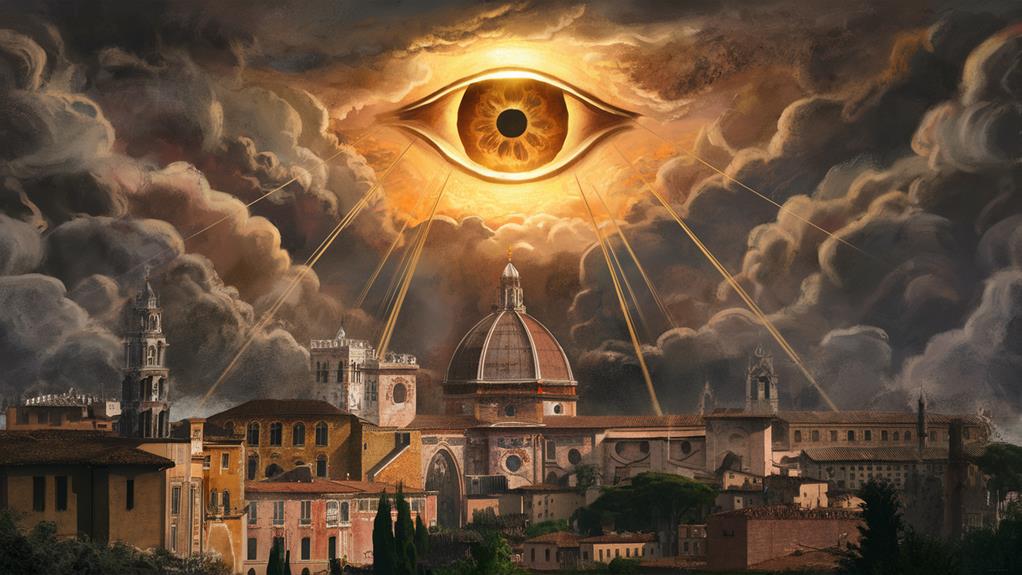
The all-seeing eye symbol has captivated artists and viewers for centuries, appearing in countless masterpieces from the Renaissance to modern times. You’ll discover this potent symbol nestled within the compositions of history’s most renowned paintings, where it’s often depicted as a singular eye enclosed in a radiant triangle. This divine emblem represents not just omniscience but your inherent connection to universal consciousness.
When you explore paintings like Pontormo’s “Vertumnus and Pomona” or the ceiling of the Vatican’s Sistine Chapel, you’ll notice how artists have cleverly integrated this symbol to suggest divine presence and cosmic awareness. The all-seeing eye serves as a bridge between earthly existence and celestial domains, reminding you of your place within the grand tapestry of existence.
In medieval and Renaissance art, you’ll find it watching over biblical scenes, while in contemporary works, it often appears as a commentary on surveillance and personal sovereignty.
This enduring symbol transcends its religious origins, speaking to your deepest questions about consciousness, observation, and the nature of reality itself.
Secret Pentagram Patterns
While the all-seeing eye draws your attention to singular focal points in artwork, hidden pentagrams reveal complex geometric patterns that artists have masterfully woven into their compositions.
You’ll discover these five-pointed stars subtly embedded within Renaissance masterpieces, where they often connect key figures or architectural elements in ways that weren’t immediately apparent to casual observers.
In Leonardo da Vinci’s “The Last Supper,” you’ll find an intricate network of pentagrams linking the apostles to Christ, creating sacred geometry that speaks to divine proportion and spiritual harmony.
Similarly, Botticelli’s “Primavera” contains carefully plotted pentagonal arrangements that connect the dancing figures, suggesting deeper mystical meanings beneath the pastoral scene.
When you’re examining Gothic cathedral architecture in paintings, you’ll notice how artists frequently incorporated pentagram patterns into window arrangements and structural elements, reflecting medieval beliefs about cosmic order.
These geometric configurations weren’t merely decorative—they represented the artists’ understanding of universal mathematical principles and their connection to divine creation.
You’re witnessing a sophisticated visual language that bridges the physical and metaphysical domains, speaking across centuries to those who understand its significance.
Hidden Alchemical References
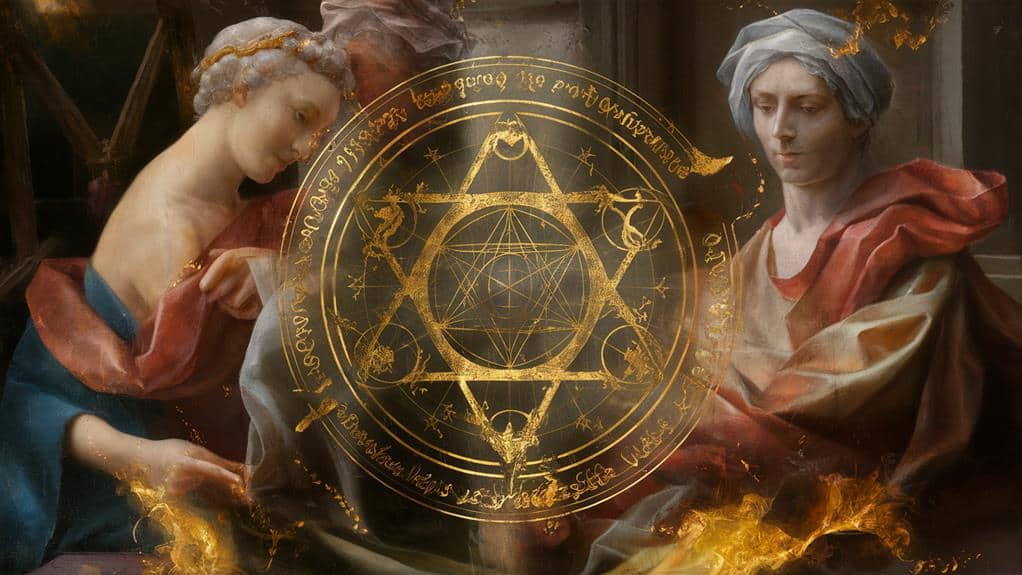
Medieval artists frequently embedded alchemical symbols into their works, encoding esoteric knowledge about transformation and spiritual enlightenment.
You’ll discover these mystical elements hidden in plain sight: the green lion devouring the sun in illuminated manuscripts, or the sacred marriage of opposing forces depicted through intertwined serpents in cathedral stonework.
As you examine Renaissance masterpieces more closely, you’ll notice recurring symbols of transmutation: the philosopher’s stone often appears as a red crystal or gem, while mercury’s dual nature manifests as twin birds or mirrored figures.
In Hieronymus Bosch‘s works, you’ll find alchemical vessels and furnaces disguised within fantastical landscapes, each element carefully positioned to convey steps in the Great Work. The artist’s laboratory becomes a metaphor for the soul’s transformation.
You’re witnessing an ancient visual language that transcends time, where each symbol – whether it’s the peacock’s tail representing colorful stages of transformation, or the black crow signifying dissolution – carries profound meaning.
These artists weren’t just creating beautiful images; they were preserving and transmitting sacred knowledge through their brushstrokes, inviting you to reveal their cryptic messages.
Sacred Geometry in Architecture
Sacred proportions echo throughout history’s greatest architectural achievements, from the precise measurements of Egyptian pyramids to the sweeping arches of Gothic cathedrals.
You’ll find the divine ratio, phi (1.618), embedded within these structures like a cosmic fingerprint, revealing humanity’s enduring quest to mirror heaven’s mathematical perfection in earthly form.
As you explore these architectural marvels, you’ll discover how master builders incorporated the Fibonacci sequence into their designs, creating spaces that resonate with universal harmony.
You can trace these golden spirals in Notre Dame’s rose windows, where sacred geometry transforms light into transcendent displays of divine order.
The octagonal symmetry of the Dome of the Rock speaks to you of celestial perfection, while the precise proportions of Greece’s Parthenon still captivate your mathematical mind.
You’re witnessing more than mere construction when you study these principles – you’re connecting with an ancient wisdom that understood buildings as bridges between earthly and divine domains.
In each carefully calculated angle and measurement, you’ll find evidence of humanity’s timeless desire to encode spiritual truths within physical form.
Masonic Handshakes and Gestures
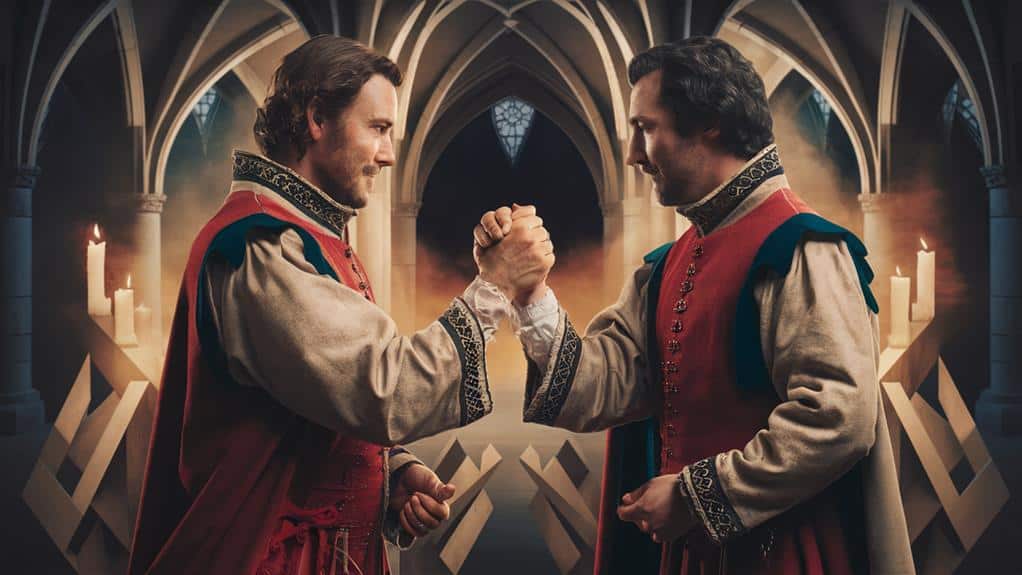
The ancient wisdom of sacred geometry extends beyond architecture into the sphere of human movement and gesture, particularly in Masonic traditions. You’ll find these symbolic gestures carefully preserved in classical paintings, where artists have encoded specific hand positions and grips that carry deeper esoteric meanings.
When you study these artworks closely, you’ll notice how the seemingly casual placement of hands often reveals carefully choreographed positions. The “real grip” of the Master Mason, for instance, appears in numerous Renaissance paintings, where figures clasp hands in ways that might seem awkward to the uninitiated observer.
Leonardo da Vinci’s works frequently incorporate these subtle signals, with fingers positioned at precise angles that mirror Masonic degrees and initiatory levels.
You’re witnessing a hidden language in plain sight, where every finger placement and hand position serves as a silent communicator of profound truths. These gestures connect viewers to an ancient tradition of wisdom, forming bridges between visible and invisible domains.
Through these encoded movements, you’re accessing a timeless dialogue between initiated brothers who’ve preserved their sacred knowledge in the universal language of art.
The Green Language Code
Hidden within Renaissance art lies a sophisticated system of symbolic communication known as the Language of the Birds, or Green Language, used by alchemists and esoteric scholars to encode spiritual wisdom.
You’ll find this ancient code woven throughout masterpieces, where artists transformed mundane objects into vessels of hidden meaning through wordplay, visual puns, and multilingual associations.
When you’re examining works by masters like Da Vinci or Botticelli, you’ll notice how they’ve embedded this enigmatic language through careful placement of birds, plants, and celestial symbols.
The Green Language operates on multiple levels of meaning – what appears as a simple dove might represent both the Holy Spirit and the philosophical mercury of alchemy, while a rose can simultaneously symbolize divine love and the process of spiritual transformation.
You’re witnessing a tradition that stretches back to medieval times, where initiates communicated profound truths through seemingly innocent imagery.
Rosicrucian Rose Symbols
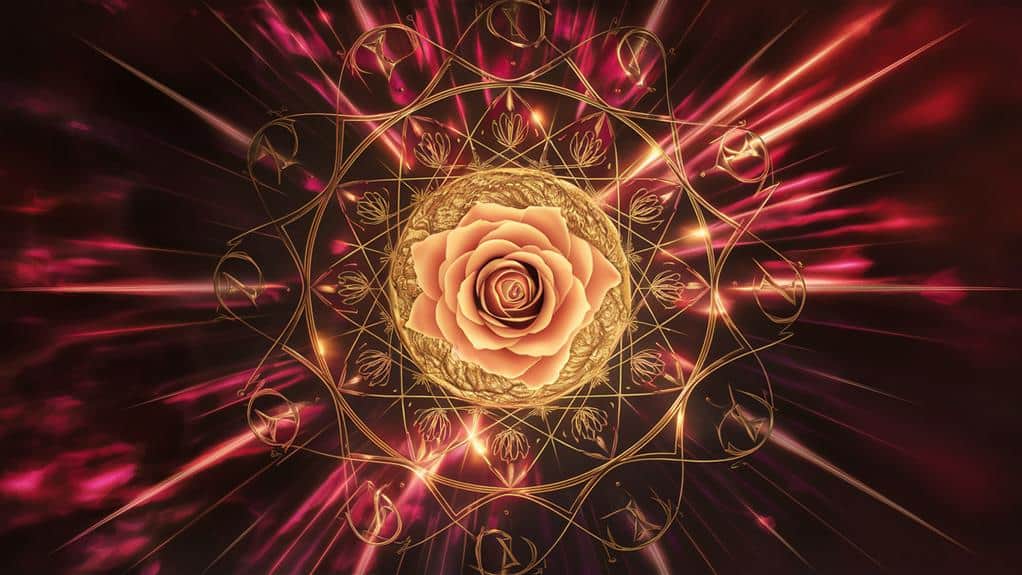
Mystical roses crop up throughout Renaissance and Baroque paintings as secret markers of Rosicrucian influence, an esoteric brotherhood that used the rose as their primary emblem.
You’ll find these symbolic blooms nestled within detailed compositions, often paired with crosses, celestial objects, or geometric patterns that speak to the order’s blend of Christian and Hermetic wisdom. When you’re examining works by artists like Botticelli or Dürer, look for roses with specific petal counts – five petals represent the five wounds of Christ, while seven suggest divine perfection.
You’ll discover that these Rosicrucian roses aren’t merely decorative elements; they’re encoded messages about spiritual transformation and hidden knowledge.
In paintings where the rose appears with a compass or square, it’s pointing to the brotherhood’s interest in sacred geometry. When you spot a rose emerging from thorny branches, it’s symbolizing the soul’s journey through material suffering toward enlightenment.
The placement of these roses often creates invisible lines connecting to other esoteric symbols, forming what initiates called the “Rose Cross” – a template for understanding the universe’s divine architecture.
Kabbalah Tree of Life
Among Renaissance masterpieces, you’ll find intricate diagrams of the Kabbalah Tree of Life embedded as geometric patterns that map out divine creation through ten interconnected spheres called Sephirot. Each sphere represents a divine attribute flowing from the infinite source, creating a cosmic framework that artists have woven into their compositions through subtle geometric alignments and sacred proportions.
You’ll discover this mystical symbol cleverly hidden in works like Botticelli’s “Primavera,” where the positioning of figures mirrors the Tree’s structure, connecting earthly beauty to divine wisdom.
The Tree’s presence isn’t always obvious – it’s often concealed within architectural elements, figure arrangements, or landscape features that reveal themselves only to those who understand its sacred geometry. When you trace these patterns, you’re following the same contemplative path that mystics and artists have walked for centuries, seeking to understand the connection between human consciousness and divine reality.
The Tree’s vertical pathways guide your eye through the artwork’s composition, leading you from material reality through emotional and intellectual spheres toward the crown of ultimate understanding.
Hermetic Compass and Square
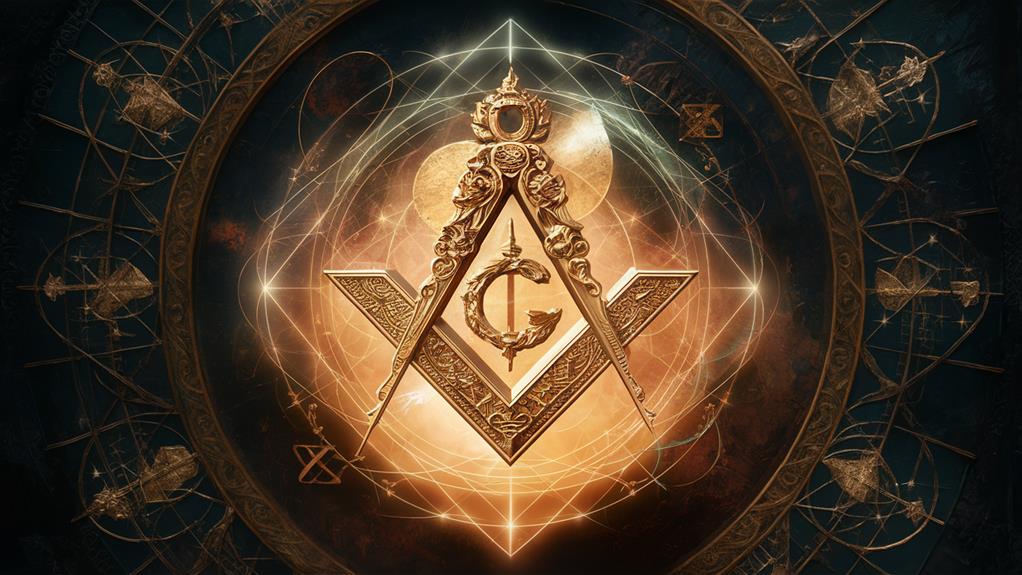
The sacred compass and square, ancient tools of geometry and measurement, appear throughout Renaissance and Baroque art as potent symbols of divine order and cosmic harmony.
You’ll find these emblems subtly woven into compositions where they serve as bridges between earthly craftsmanship and celestial design, reflecting humanity’s eternal quest to understand universal patterns.
When you’re examining masterworks from this period, you’ll notice how artists incorporated the compass’s circular motion and the square’s right angles to express fundamental truths about creation.
The compass, pointing upward, represents spirit and divine inspiration, while the square, oriented horizontally, symbolizes matter and earthly manifestation.
Together, they’re speaking an ancient language of sacred geometry that’s still relevant today.
You’re witnessing, through these symbols, the artists’ profound understanding of hermetic principles – “as above, so below.”
In paintings where these tools appear, they’re often positioned near figures of saints, philosophers, or architects, suggesting that divine wisdom flows through human hands.
Whether carved in stone or painted with oils, these symbols remind you that you’re part of a grand cosmic architecture, where every measurement reflects divine proportion.
Ancient Egyptian Mystery Signs
Sacred symbols from Egypt’s rich spiritual tradition continue to intrigue art historians and mystics alike, appearing throughout Western paintings as powerful emblems of hidden wisdom.
You’ll find the ankh, ancient Egypt’s symbol of eternal life, subtly woven into Renaissance masterpieces, often held by angelic figures or hidden within architectural details that most viewers might overlook.
When you explore these artworks more deeply, you’ll discover the Eye of Horus watching from shadowy corners, promising protection and spiritual insight to those who understand its significance.
The scarab beetle, representing transformation and rebirth, appears in unexpected places – sometimes as jewelry worn by portrait subjects, other times as decorative elements in still life paintings.
You’re witnessing an artistic tradition where Western painters deliberately incorporated these Egyptian mystery symbols to encode esoteric teachings within their work.
They’ve left clues in the form of lotus flowers, symbolizing spiritual awakening, and the distinctive double crown of Upper and Lower Egypt, representing the unity of opposing forces.
These symbols serve as bridges between ancient wisdom and Renaissance thought, creating layers of meaning that you can still uncover today.



